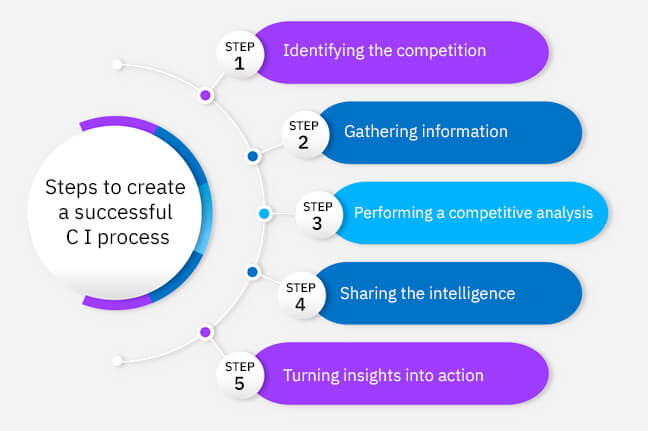What is a competitive intelligence process?
Competitive intelligence (CI) is any actionable information collected on competitors, customers, and other market factors that contribute to a business’s competitive advantage. However, to ensure that this is done effectively, organizations need a process. The process of defining, gathering, analyzing, and distributing information regarding competitors, customers, products, and changes in the industry or macro-environment in a functional manner, thus, constitutes the competitive intelligence process. The nature of competitive intelligence varies for different companies, depending on the industry, circumstance, and a host of other factors. Thus, each organization has a slightly different process, which is designed accordingly. The steps in the process, however, are more or less the same. This process helps organizations by developing a detailed portrait of the market landscape and competitors, so that they may anticipate and proactively respond to challenges and problems. Now, let’s take a look at the steps to build such a process.
Steps to create a successful competitive intelligence process

A CI process will get better and more refined the longer you use it, as it is only after you’ve seen what works and what doesn’t work in the process that you can make changes and improve it. Until then, using the best practices as listed down by successful global organizations would be ideal. Here is an outline of the process that’ll help you create your own.
Step one: Identifying the competition
There can be no competitive intelligence process without identifying who your competitors are. The first step to initiate your CI program, thus, should be to identify your top five direct competitors, as well as five of your indirect competitors, your new or emerging competitors, your aspirational competitors, and your perceived competitors. If your competitive landscape isn’t that large, start with the top three of each. This data should then be used to perform a competitive analysis, which will help you understand the market and competitive landscape clearly. You may segment your competitive landscape even further if you want, and compare competitors by industry focus, product or service type, marketing strategy, customer sentiment, etc.
Step two: Gathering information
Once you’ve identified your competitors, now it’s time to gather the intel. This is where the actual research takes place. You’ll gather information on the competitors’ online presence, their products, websites, teams, announcements, social media engagements, content, etc. While aggregating this information manually isn’t difficult, it certainly is a laborious task, and requires time and effort. A competitive intelligence tool or software can help speed up this process, and get you regular intel on your competitors much faster than the traditional way. The more actionable information you have on your competitors, the easier it’ll be to perform a competitive analysis later on, which is why it is important to pay attention during this part of the CI process.
Step three: Performing a competitive analysis
This is an important step, as without proper analysis, your gathered intel isn’t likely to add any value to the various stakeholders in the organization. Using the intel, your CI manager, or a person in an equivalent role will identify key trends and other actionable insights, and use them to create a competitive analysis (or analyses) based on various metrics. These competitive analyses will be communicated to the stakeholders to give them a clearer understanding of where they need to improve to get ahead of the competition. In addition to competitive analyses, stakeholders should also be provided with daily alerts, weekly and monthly reports (especially for the leadership), as well as battlecards (for the sales team). These can either be created by the CI manager, or if you’re using a competitive intelligence system like Contify, can be created directly in the platform itself, and shared with the respective stakeholders.
Step four: Sharing the intelligence
As already discussed in the previous point, you need to share the deliverables created using the gathered intelligence with the key stakeholders in the organization. It would be unfortunate if the CI team works hard to create intelligence deliverables that aren’t consumed due to a lack of proper delivery. A lot of organizations use emails, internal chats as well as meetings to communicate their intelligence to the stakeholders, but these can be missed. The best way, perhaps, is to integrate your competitive intelligence into your CMS, so that the intel can be delivered directly to the stakeholders wherever they are. A number of competitive intelligence platforms these days support integration with CMSs, and can be used to your advantage.
Step five: Turning insights into action
The purpose of competitive intelligence is to provide you with “actionable” intelligence. Thus, the final step of the competitive intelligence process is to turn insights into action. The various stakeholders in the organization are responsible for this step, and the intelligence shared with them will help them play their respective roles in the overall business strategy. For example:
– The leadership or C-suite are the decision-makers in an organization, and will use the insights to create business strategies that steer the organization in the right direction. Ensure that you provide them with timely and relevant insights, and that you deliver these insights through a channel that they prefer.
– The marketing team will use the insights to implement new marketing campaigns and activities, as well as improve the old ones. Insights into the competitors marketing activities will also give them ideas about what sort of content marketing they should focus on.
– Sales team will use the intelligence to improve their sales collateral, demo scripts, and the overall sales process. In addition, intelligence can be used to create or improve sales battlecards and competitor profiles. CI is especially important for sales teams as they’re the ones competing with your rivals in the field, and need all the information they can get on your competitors.
– The product team will use CI to improve their own products or services, and/or work with marketing to position the product/service in a way that influences customers/clients to buy it.
Download M&CI Process Template
Benefits of using a competitive intelligence software in your process

You’ve probably noticed that competitive intelligence software has been mentioned in this article several times. While different competitive intelligence software might have different features, and thus provide different benefits, the overarching benefit every CI software or tool will provide is saved time and resources. Digital technologies have changed the way business activities are undertaken, which also includes competitive intelligence. For the purpose of this article, let us focus on the benefits of a popular market and competitive intelligence software.
– Comprehensive Market Analysis: Assists you in identifying trends in the market and determine where the industry is headed by delivering personalized insights to your stakeholders.
– Competitor Tracking: Helps you track your competitors’ digital footprint across websites, media coverage, announcements, and thousands of other sources, in an ever-changing market landscape.
– Competitive Intelligence Automation: You can automate routine competitive intelligence tasks, streamline analyst workflows and save time spent on manual research and information processing through Contify’s competitive intelligence system.
– Sales and Account Management: Provides noise-free, intelligent updates customized to each member of your sales and account management teams to drive conversations and conversions.
– User-friendly Formats: Insights and intelligence are delivered in formats that facilitate analysis and decision-making, like reports, daily alerts, news APIs and/or custom newsletters.
– Suitable For All: It is suitable for all businesses and teams. Different pricing and versions are available as per your requirement. The MI essential provides all essential features needed for small and medium-sized companies, while the Market Intelligence Enterprise is a comprehensive and customized solution tailored for big corporates.
– CMS Integration: Easy to integrate into your organization’s CMS, so that you get insights delivered directly to your stakeholders’ inboxes.
How Contify can help in generating more leads

Most organizations would agree that lead generation is a joint responsibility of the marketing and sales teams. A competitive intelligence tool like Contify can be a valuable asset for the marketing and sales teams. Here’s how.
1. Ensures you stay on top of your competitors’ marketing move and strategy
Contify lets you formulate a proactive marketing strategy by learning about your competitor’s strategy much before it’s announced in press releases, through continuous monitoring of their websites, news, blogs, and articles, along with information from over 200,000 sources. Discovery of the competitors’ strategies in advance can help design counter-promotion campaigns, which will also generate leads.
2. Helps you create competitive differentiation
Contify lets you craft messaging that resonates with your customers. By analyzing your competitors’ messaging, you can develop your own differentiated and persuasive messaging. Contify can also help identify the unmet needs of the customers to develop marketing collateral that help differentiate your offerings from those of your competitors, thus, generating more leads.
3. Facilitates sales enablement
Contify helps drive revenue and improve sales by helping create winning case studies, marketing collateral, and battle cards with actionable and relevant intelligence on competing products, pricing, and promotions. This will help your sales team effectively handle objections, craft rebuttals, generate more leads, and win more deals.
Take a free trial of Contify’s Market and Competitive Intelligence Platform >>
Conclusion
Following the process described above will let you pull out key pieces of intel and communicate them to your team effectively, allowing you to derive value from your CI program. However, CI tools and software have become a necessity in a world where more and more organizations are using competitive intelligence. Using CI tools and software will make your CI process much more efficient, as most of the labor and time-intensive tasks in the process are taken care of automatically.
The goal of competitive intelligence is to enable your organization to better understand your market and competitors, make stronger strategic decisions, and ultimately increase revenue. In this highly competitive business world, anything that gets you closer to that goal should be welcomed.



